Are you curious about the official bird of North Carolina? Look no further than the Northern Cardinal, a vibrant red bird that is a common sight throughout the state.
This beloved bird is known for its beautiful plumage and melodic song, making it a favorite among birdwatchers and nature enthusiasts alike.
The Northern Cardinal has a rich history in North Carolina, having been designated as the state bird in 1943. Since then, it has become a beloved symbol of the state’s natural beauty and wildlife.
In this article, you will learn more about the Northern Cardinal’s physical characteristics, habitat, behavior, and cultural significance, as well as the conservation efforts aimed at protecting this iconic species.
Table of Contents
- 1 Introduction to the North Carolina State Bird
- 2 History of the North Carolina State Bird
- 3 Physical Characteristics of the Northern Cardinal
- 4 Habitat and Distribution of the Northern Cardinal
- 5 Behavior and Diet of the Northern Cardinal
- 6 Conservation Status and Threats to the Northern Cardinal
- 7 Symbolism and Cultural Significance of the Northern Cardinal in North Carolina
- 8 Conclusion
- 9 Frequently Asked Questions
- 9.1 What other states have the Northern Cardinal as their state bird?
- 9.2 How long do Northern Cardinals typically live in the wild?
- 9.3 Are there any superstitions or myths associated with the Northern Cardinal in North Carolina?
- 9.4 What is the Northern Cardinal’s mating behavior, and how do they raise their young?
- 9.5 Are there any interesting adaptations or unique features that the Northern Cardinal has compared to other bird species in North Carolina?
- 10 Author
Introduction to the North Carolina State Bird
So, let’s talk about the North Carolina State Bird!
Before we dive into the specifics, it’s important to understand what a state bird is and why it matters.
Essentially, a state bird is a bird species that a particular state has officially designated as a symbol of its identity and heritage.
For North Carolina, the state bird is the Northern Cardinal, a bright red bird with a distinctive crest that’s native to the eastern United States.
Explanation of what a state bird is and its significance
Understanding the importance of a state bird highlights the significance of local wildlife and culture. State symbols, such as the state bird, are chosen to represent the unique characteristics and values of a particular state.
The state bird is not only a symbol of pride for the state, but it also serves as a reminder of the importance of preserving the natural environment and the wildlife that inhabit it.
The state bird of North Carolina is the Northern Cardinal, also known as the redbird. This bird was chosen as the state bird in 1943 due to its vibrant red color and its year-round presence in the state.
The Northern Cardinal is a common sight in North Carolina, and its distinctive song can be heard throughout the state.
In addition to its beauty and prevalence, the Northern Cardinal is also a symbol of faith and loyalty, making it a fitting choice for the state bird of North Carolina.
Brief overview of the state bird of North Carolina
Take a look at the vibrant red Northern Cardinal, known as the redbird, chosen to represent the state of North Carolina as its official state bird.
This bird is a year-round resident of the state, making it a fitting representation. The Northern Cardinal is also a symbol of faith and loyalty, two traits that the state of North Carolina values highly.
Here are some interesting facts about the North Carolina state bird:
- The Northern Cardinal is a songbird, known for its beautiful and distinctive call.
- The male Northern Cardinal is a bright red color, while the female is a more muted brown color with touches of red.
- The Northern Cardinal has a distinctive crest on the top of its head, which adds to its unique appearance.
- The Northern Cardinal is a popular bird for birdwatchers, and can be found in backyards across the state.
Now that you know a little bit about the physical characteristics of the North Carolina state bird, let’s take a closer look at the history of the Northern Cardinal as the state bird of North Carolina.

History of the North Carolina State Bird
When discussing the history of the North Carolina state bird, it’s important to consider its origins.
The bird in question is the cardinal, a bright red songbird that is native to the state.
The cardinal was officially designated as the state bird in 1943, after a lengthy selection process.
Origins of the state bird of North Carolina
The origins of the state’s avian symbol can be traced back to 1943, when the cardinal was designated as the official bird by the General Assembly.
There are several interesting facts about the history of the Northern Cardinal as the state bird of North Carolina. Here are three things you might find fascinating:
- The Northern Cardinal, also known as the redbird or common cardinal, is a widespread bird found across the eastern United States, from Maine to Texas.
- The male Northern Cardinal is known for its vibrant crimson plumage and distinctive crest, while the female is more muted with a reddish-brown hue.
- The Northern Cardinal has long been associated with symbolism and cultural significance, with some Native American tribes considering it a symbol of love and devotion.
As you can see, the Northern Cardinal has a rich history as the North Carolina state bird. But how exactly was it chosen? Read on to learn about the process of selecting the state bird.
The process of selecting the state bird
You might be interested in how y’all chose your official feathered symbol, so let’s talk about the process of selecting it.
In 1943, the North Carolina General Assembly passed a law to establish the state bird. Several bird species were suggested, but the northern cardinal received the most votes.
The history of the northern cardinal as the state bird of North Carolina dates back to the 17th century, when early European naturalists first noticed the vibrant red bird in the state.
The northern cardinal is found throughout North Carolina, from the coastal plains to the mountains, and it was chosen because of its colorful plumage, melodic song, and widespread distribution.
This bird is a common sight in many backyards, parks, and forests across the state.
| Year | Finalists | Winner |
|---|---|---|
| 1943 | Eastern Bobwhite, Wild Turkey, Northern Cardinal, Carolina Parakeet, Cedar Waxwing | Northern Cardinal |
Note: The table shows the year of the selection, the bird finalists that were considered, and the winner which was ultimately chosen as the state bird of North Carolina.
Historical significance of the state bird
Now that you know how the state bird of North Carolina was selected, let’s delve into the historical significance of the eastern cardinal.
The eastern cardinal, also known as the northern cardinal, has been a symbol of power and vitality for centuries.
Native American tribes believed that the bird’s bright red feathers represented the life force and the sun’s energy.
The bird’s name, cardinal, comes from the bright red robes worn by Catholic cardinals, which the bird’s plumage resembles.
In North Carolina, the eastern cardinal holds particular significance as it is one of the most common birds seen throughout the state.
The bird’s distinctive appearance and beautiful song have made it a beloved symbol of the state. It is often featured in artwork and literature, and its image can be found on everything from t-shirts to license plates.
The eastern cardinal is a beloved North Carolina icon and a fitting representation of the state’s natural beauty.
Speaking of its distinctive appearance, let’s take a closer look at the physical characteristics of the northern cardinal.
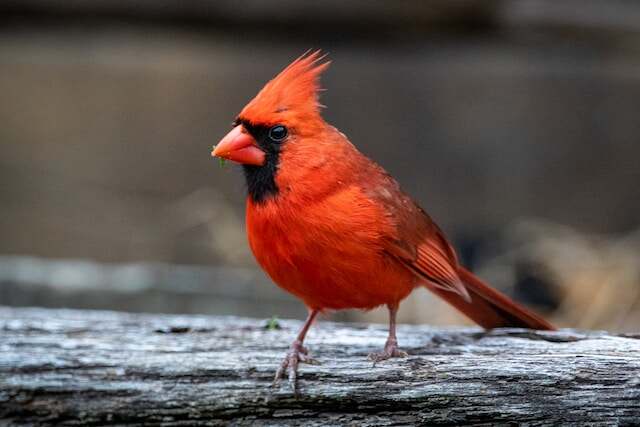
Physical Characteristics of the Northern Cardinal
To discuss the physical characteristics of the Northern Cardinal, you can start by describing its appearance.
The bird is known for its striking red plumage, with males having a black face and throat and a distinctive crest on their heads.
Females have a more subdued coloration, with a reddish-brown hue and a grayish face.
Additionally, the bird has some unique physical features, such as its strong, cone-shaped beak that’s perfect for cracking open seeds and fruits.
Description of the bird’s appearance
The North Carolina State Bird, the Eastern Cardinal, is known for its striking appearance. The bird’s plumage is so vibrant and stunning, it’s like a rainbow came to life.
The male Cardinal has a bright red crest on its head and a black mask around its eyes, while the female has a more muted reddish-brown color with a crest and mask outlined in gray.
Their wings and tail feathers are a rich brown color, and their beaks are a distinctive bright orange-red.
This bird is a common sight in North Carolina, with a healthy bird population that’s enjoyed by many birdwatchers.
In addition to their colorful appearance, the Eastern Cardinal also has a unique physical feature. Both male and female birds have a prominent crest on their head that can be raised or lowered depending on their mood.
When they’re feeling threatened or aggressive, the crest will be raised to make them appear larger and more intimidating.
This behavior can often be observed during mating season, when males will defend their territory from other males.
The Eastern Cardinal is truly a remarkable bird, with both beauty and fascinating physical characteristics.
Unique physical features of the bird
With a distinctive crest on its head that can be raised or lowered depending on its mood, the Eastern Cardinal has fascinating physical features. This bird is known as the North Carolina state bird and is native to the eastern United States.
Here are some of the unique physical characteristics of the Eastern Cardinal:
- The male Eastern Cardinal has bright red feathers on its head, wings, and tail, making it easily visible in any environment. The female has a reddish-brown color on its feathers, serving as camouflage while nesting and taking care of its young.
- The Eastern Cardinal has a strong, thick beak that helps it crack open tough seeds and fruits. This feature allows it to be an efficient seed disperser and helps maintain the ecosystem by spreading seeds of various plants.
- Both male and female Eastern Cardinals have a black mask around their eyes, which helps reduce glare and improve vision while hunting for food.
The Eastern Cardinal is not only known for its physical attributes, but it also holds symbolic importance in North Carolina.
The redbird is a common nickname for the Eastern Cardinal, and it is often associated with love, passion, and energy.
This bird is a prominent figure in North Carolina’s culture and is frequently mentioned in literature, songs, and art.
As you transition into the subsequent section about the habitat and distribution of the Northern Cardinal, it’s essential to understand the physical characteristics of the bird that enable it to thrive in various environments.
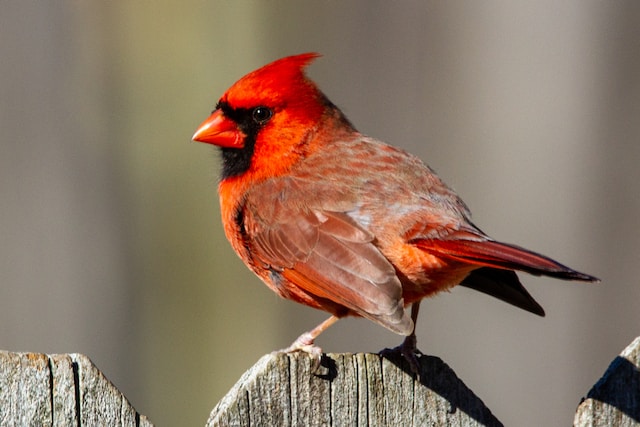
Habitat and Distribution of the Northern Cardinal
When discussing the habitat and distribution of the Northern Cardinal, it’s important to note that these birds are native to North America. They can be found throughout the eastern United States, from Maine to Texas.
Cardinals typically inhabit dense shrubs and low trees, and they’re known for their bright red plumage, making them easy to spot in their natural habitat.
In terms of migration patterns, Northern Cardinals are non-migratory birds. This means they stay in their natural habitat year-round.
The bird’s natural habitat
You’ll find this feathered friend fluttering around the forests and woodlands of its native range in North Carolina.
The Northern Cardinal, also known as the North Carolina state bird, can be found in a variety of habitats, including dense shrubs, thickets, and forest edges.
These habitats provide the bird with ample cover for nesting and feeding, as well as protection from predators.
If you want to catch a glimpse of this beautiful bird in its natural habitat, there are a few birding hotspots in North Carolina that are worth checking out.
Some of the best places to see the Northern Cardinal include the Great Smoky Mountains National Park, the Blue Ridge Parkway, and the Outer Banks.
Whether you’re an experienced birder or just starting out, these locations offer a chance to see this iconic bird up close and in person.
So pack your binoculars and head out to one of these North Carolina bird habitats to see the Northern Cardinal for yourself.
Geographical distribution of the bird
If you’re curious about where this beautiful bird can be found, take a look at its geographical distribution across the eastern United States.
The North Carolina state bird, the Northern Cardinal, can be found throughout most of the eastern half of the United States, from Maine to Texas and as far north as southern Canada.
This bird is particularly common in forest edges, suburban areas, and backyards. They also thrive in areas with thickets, shrubs, and dense vegetation.
The Northern Cardinal is not migratory and is known for its ability to adapt to various environments and climates.
They are commonly found in the southeastern United States, including North Carolina, where they are the state bird.
However, they can also be spotted in the northern regions of the country during the winter months.
This bird is a year-round resident in its range, making it easy to spot and appreciate its vibrant red plumage and sweet, melodic song.
Migration patterns
The Northern Cardinal is known for its adaptability and can be found throughout much of the eastern United States year-round, although they may also be spotted in northern regions during the winter months.
Here are some interesting facts about the migration patterns of the North Carolina state bird, the Eastern Cardinal:
- While the Northern Cardinal isn’t considered a migratory bird, some individuals do undertake seasonal movements in response to food availability and weather conditions.
- Northern Cardinals that breed in the northern parts of their range tend to move southward during the winter months, while those that breed in the southern parts of their range may remain in the same area throughout the year.
- The timing and extent of these movements can vary from year to year and are influenced by factors such as climate change and habitat loss.
- Scientists are studying the migration patterns of Northern Cardinals to better understand how they may be affected by these and other environmental factors.
Understanding the migration patterns of the North Carolina state bird, the Eastern Cardinal, is essential in ensuring the species’ survival.
In the next section, we’ll explore the behavior and diet of this fascinating bird.

Behavior and Diet of the Northern Cardinal
When discussing the behavior and diet of the Northern Cardinal, it’s important to consider its social behavior.
These birds are known for their monogamous mating habits and year-round territoriality. Additionally, they have been observed exhibiting a variety of complex social behaviors, such as vocal communication and mate feeding.
Moving on to feeding habits, Northern Cardinals are primarily seed-eaters, but also consume insects and fruits. Their diet can vary depending on the season and availability of food sources.
Finally, when it comes to reproduction and mating behavior, Northern Cardinals typically mate for life and both parents are involved in raising their young.
Nest-building and courtship rituals are also fascinating aspects of their behavior to explore.
Social behavior of the bird
You’ll be fascinated to learn about the social behavior of the North Carolina state bird, the Northern Cardinal. These birds communicate with each other through a variety of vocalizations, including songs, calls, and even non-vocal sounds like bill snaps.
They also form strong bonds with their mate, often staying together for many years. In fact, Northern Cardinals are known to be monogamous and will defend their territory and mate fiercely.
Here are four interesting facts about the social behavior of the Northern Cardinal in North Carolina:
- Cardinals use different vocalizations to communicate different messages, such as warning calls for predators or territorial songs to defend their space.
- Males and females have different roles in raising their young. Females typically incubate the eggs and care for the chicks, while males bring food to the nest and help protect the family.
- Cardinals are known to engage in courtship displays, including feeding their mate and singing duets together.
- In many cultures, the cardinal bird symbolism is associated with love, loyalty, and devotion, which reflects the bird’s strong bond with its mate.
As you can see, Northern Cardinals are not only beautiful birds but also fascinating creatures with complex social behavior. Their strong bonds with their mate and vocal communication are just a few examples of their unique characteristics.
Now, let’s move on to the feeding habits of the bird.
Feeding habits of the bird
You might be interested in learning about what the North Carolina state bird, the Northern Cardinal, likes to dine on. These birds are known to have a varied diet, consisting of insects, fruits, and seeds.
During the summer months, they primarily feed on insects like beetles, grasshoppers, and snails, while in the winter months, they switch to a diet of seeds and fruits like sunflower seeds, millet, and blackberries.
The behavior and diet of the Northern Cardinal in North Carolina vary depending on the season. During the breeding season, they’re known to be more insectivorous, as they need to provide a protein-rich diet for their young.
However, during the non-breeding season, they switch to a more seed-based diet. They’re also known to be ground feeders, often foraging for food on the ground or low tree branches.
Their varied diet makes them an important part of the ecosystem in North Carolina, as they help control insect populations and spread plant seeds.
Now, let’s move on to the next section about their reproduction and mating behavior.
Reproduction and mating behavior
Let’s talk about the Northern Cardinal’s reproduction and mating behavior, which is just as fascinating as their diverse diet.
As the North Carolina state bird, the Eastern Cardinal physical characteristics are quite striking, with the males sporting bright red feathers and the females having a more subdued reddish-brown color.
During the breeding season, males will sing to attract a mate, and once paired, they will continue to sing to defend their territory and communicate with their partner.
When it comes to bird reproduction, Northern Cardinals are monogamous, meaning they mate with one partner for life.
The female will lay 2-5 eggs in a nest made of twigs, grass, and other plant materials, which is typically built in a shrub or tree. Both parents take turns incubating the eggs and feeding the chicks once they hatch.
It takes about 10-11 days for the eggs to hatch, and the chicks will fledge, or leave the nest, after about 10-11 days.
It’s amazing to think that these beautiful birds go through this process every year to ensure the survival of their species.
Moving on to the next section, it’s important to note that while the Northern Cardinal is a common sight in many parts of the United States, there are still threats to their population.
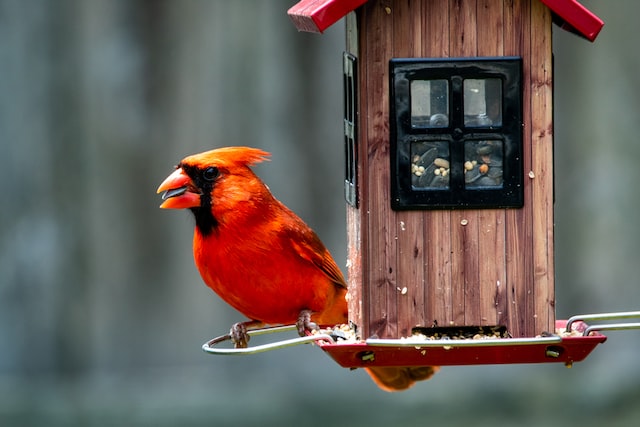
Conservation Status and Threats to the Northern Cardinal
Let’s dive into the conservation status of the Northern Cardinal, the state bird of North Carolina.
Firstly, it’s important to note that the International Union for Conservation of Nature (IUCN) has listed the bird as a species of least concern.
However, threats to the bird’s habitat and population still exist. These threats include habitat loss and fragmentation, collisions with buildings, and predation by domestic cats.
Current conservation status of the bird
Unfortunately, the conservation status of the North Carolina state bird, the Northern Cardinal, isn’t looking too great. While the species as a whole isn’t considered endangered, the population in North Carolina is declining.
Here are some reasons why:
- Habitat loss: As urbanization and development continue to spread throughout North Carolina, the Northern Cardinal’s natural habitat is shrinking.
- Climate change: The changing climate is altering the bird’s habitat and disrupting their migratory patterns.
- Predation: The Northern Cardinal is a common target for predators such as cats, snakes, and even larger birds.
- Disease: The bird is susceptible to various diseases, including the deadly salmonellosis.
With these threats to the bird’s population in North Carolina, it’s important to take action to protect this beautiful species.
Threats to the bird’s habitat and population
You need to understand the threats that are putting the North Carolina state bird, the Northern Cardinal, at risk, so you can take action to protect this stunning creature.
The conservation status of the Northern Cardinal is currently listed as a species of least concern, but that doesn’t mean it’s not facing serious threats.
One of the biggest threats to the bird’s habitat and population is habitat loss due to urbanization and agricultural expansion.
As more and more land is cleared for development, the Northern Cardinal’s natural habitat is being destroyed, leaving the bird with fewer places to nest and breed.
Another threat to the Northern Cardinal in North Carolina is climate change. As the climate changes, the bird’s habitat may become less suitable for breeding, and its food sources may become scarce.
In addition, climate change is causing more frequent and severe weather events, which can damage the bird’s nests and harm its young.
To protect North Carolina bird populations, it’s important to take steps to mitigate these threats and ensure that the Northern Cardinal’s habitat is conserved and protected.
Efforts to protect the bird and its habitat
The Northern Cardinal, with its vibrant red plumage, is a beloved bird that has captured the hearts of many, and thankfully, efforts to protect its habitat are paying off, as the bird’s population has increased by 28% over the last 50 years.
North Carolina, which designated the Northern Cardinal as its state bird in 1943, has taken significant steps to preserve the bird’s habitat and promote its conservation.
One of the state’s most successful conservation programs is the Wildlife Habitat Incentives Program, which provides financial assistance to landowners who implement conservation practices on their property.
Additionally, the North Carolina Wildlife Resources Commission has designated the Northern Cardinal as a priority species, which means that the commission focuses on monitoring the bird’s population and habitat, as well as providing education to the public about the bird’s importance.
These efforts have proven effective, as the Northern Cardinal remains a common sight in North Carolina’s forests and backyards.
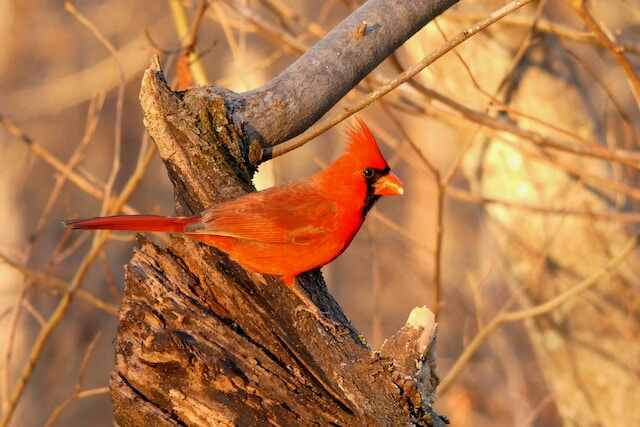
Symbolism and Cultural Significance of the Northern Cardinal in North Carolina
When preparing to discuss the symbolism and cultural significance of the Northern Cardinal in North Carolina, it’s important to consider its use as a symbol in the state.
The bird has been adopted as the state bird and is often used in logos and branding for North Carolina-based companies.
Additionally, the cultural significance of the bird to the state and its people can be explored, including its role in folklore, art, and literature.
Use of the bird as a symbol in North Carolina
You’ll see the cardinal used on many products, billboards, and advertisements throughout the state as a representation of local pride and identity.
The North Carolina state bird has become a ubiquitous symbol in the state, with its bright red plumage and distinctive chirp instantly recognizable to locals and visitors alike.
The bird’s use as a symbol is not limited to official state materials; rather, it has been embraced by businesses, sports teams, and other organizations as a way to show their connection to the state and its unique identity.
Some of the most common uses of the cardinal as a symbol in North Carolina include:
- Sports teams: Many local high schools and colleges use the cardinal as their mascot, including the North Carolina State University Wolfpack
- Souvenirs and gifts: Visitors to the state can find cardinal-themed items in gift shops and stores throughout the state, including everything from t-shirts to coffee mugs.
- Advertising: Companies that want to appeal to a North Carolina audience often use the cardinal in their advertising campaigns, as a way to tap into the state’s sense of pride and identity.
The significance of birds in North Carolina culture goes beyond just the state bird; the state is home to a wide variety of bird species, many of which are celebrated in local festivals and events.
In the next section, we’ll explore the cultural significance of the bird to the state and its people.
Cultural significance of the bird to the state and its people
As a proud resident of the Tar Heel State, you can’t help but feel a deep connection to the feathered creatures that grace the skies and symbolize the spirit of this beloved region.
The North Carolina state bird, the Cardinal, has a rich historical significance in the state. For decades, the bird has been used as a symbol of the state’s beauty and pride, and it remains an integral part of the state’s culture.
Beyond its cultural significance, the Cardinal is also a vital part of the state’s wildlife conservation efforts.
The bird’s natural habitats are protected and preserved to ensure their survival, and the state has implemented various programs to promote the conservation of the Cardinal and other wildlife species.
As a result, the people of North Carolina take great pride in their state bird, and it is a testament to the state’s commitment to preserving its natural beauty for future generations.
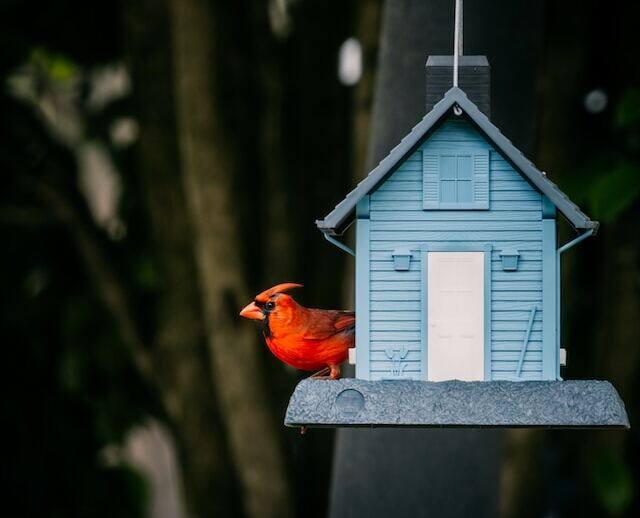
Conclusion
So now that you’ve learned about the North Carolina state bird, let’s recap some key points. The cardinal is a beautiful bird with a distinctive red color and a sweet song.
It’s also a symbol of good luck, making it a beloved and important part of North Carolina’s culture and heritage.
As we come to the end of our discussion on the North Carolina state bird, it’s important to reflect on some final thoughts.
The cardinal’s beauty and significance have made it a beloved part of North Carolina’s identity.
Whether you’re a bird enthusiast or simply appreciate the state’s natural beauty, the cardinal is a true treasure of North Carolina.
Overall, the North Carolina state bird is a fascinating and important part of the state’s history and culture.
From its vibrant red color to its sweet song, the cardinal is a true symbol of North Carolina’s natural beauty and resilience.
Whether you’re a resident or a visitor, taking the time to appreciate this beloved bird is a must.
Recap of key points
Now that we’ve covered the important details, let’s recap what we’ve learned about the North Carolina state bird, the northern cardinal.
The history of the northern cardinal as the state bird of North Carolina can be traced back to 1943 when the state’s General Assembly adopted it as the official bird.
Since then, this vibrant red bird has become a beloved symbol of the state’s wildlife, culture, and beauty. Apart from its cultural significance, the northern cardinal is also a fascinating bird to observe in North Carolina.
It is a year-round resident of the state and can be found in a variety of habitats, from forests and backyards to urban parks and gardens.
Its diet primarily consists of seeds, berries, insects, and occasionally small vertebrates. With its distinctive crest and beautiful song, the northern cardinal is truly a remarkable bird to admire in North Carolina.
Final thoughts on the North Carolina state bird
The northern cardinal is more than just a state symbol – it’s a fascinating bird to observe and appreciate in its own right.
This bright red bird with a distinctive crest is the official state bird of North Carolina since 1943.
The history of the northern cardinal as the state bird of North Carolina goes back to the early 20th century when schoolchildren voted for their favorite bird, and the cardinal won by a wide margin.
The choice was later confirmed by the North Carolina General Assembly, and the northern cardinal became the state bird.
Apart from its official status, the northern cardinal is a much-loved bird for many reasons.
For one, it’s a year-round resident in North Carolina, so you can see it in your backyard or local park at any time of the year.
Secondly, the male northern cardinal is known for its beautiful red plumage, which is a striking contrast against the winter landscape.
Finally, the northern cardinal is known for its clear, whistling song, which is a welcome sound on a quiet afternoon.
All in all, the northern cardinal is a bird that deserves to be celebrated not just as a state symbol but as a beloved bird of North Carolina.
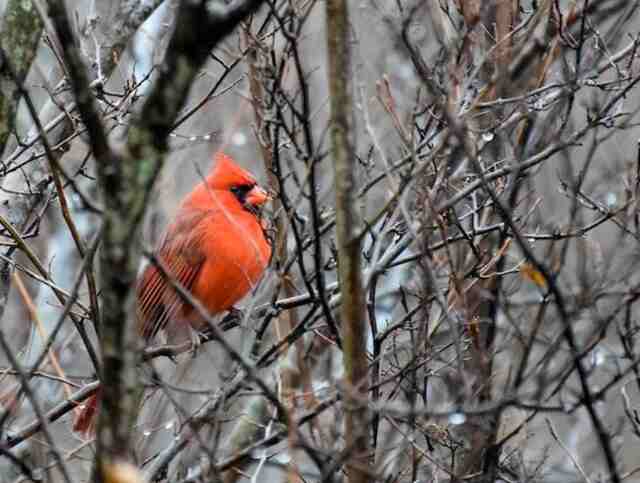
Frequently Asked Questions
What other states have the Northern Cardinal as their state bird?
Do you want to know which states boast of having the most striking state bird? Well, look no further than the northern cardinal!
This bird’s vibrant red feathers, coupled with its endearing personality, make it a favorite among many states.
Not only is it the state bird of North Carolina, but it’s also the official bird of six other states: Illinois, Indiana, Kentucky, Ohio, Virginia, and West Virginia.
That’s right! This little bird has managed to captivate the hearts of many states, making it a beloved symbol of not just one, but seven states!
How long do Northern Cardinals typically live in the wild?
Northern cardinals typically live for 3-4 years in the wild, but some can survive up to 15 years or more if they’re lucky.
This longevity is dependent on avoiding predators, disease, and environmental hazards. Backyard birds have a longer lifespan due to the availability of food, shelter, and protection from predators.
To help them survive, you can provide bird feeders, nesting boxes, and bird-friendly landscaping that mimics their natural habitat.
By doing so, you can enjoy the beauty of these vibrant birds for many years to come.
Are there any superstitions or myths associated with the Northern Cardinal in North Carolina?
Have you ever heard the myth that seeing a northern cardinal is a sign of good luck?
In North Carolina, this superstition is widely believed among bird enthusiasts and non-bird watchers alike.
Some even say that if you spot a male and female cardinal together, it means that love and happiness are in store for you.
Whether or not you believe in these superstitions, there’s no denying that the bright red plumage of the northern cardinal is a stunning sight to behold.
From its distinctive crest to its sharp beak, this bird is a true symbol of strength and vitality.
So, keep your eyes peeled for this beautiful bird, and who knows, maybe a little bit of good luck will come your way.
What is the Northern Cardinal’s mating behavior, and how do they raise their young?
If you’re curious about the mating behavior and parenting habits of the northern cardinal, you’ll be interested to learn that these birds are monogamous and mate for life.
During the breeding season, the male cardinal becomes very territorial and will defend his chosen nesting site from other males.
Once the female has laid her eggs, both parents take turns incubating them and feeding the hatchlings once they arrive.
The young cardinals will stay in the nest for up to two weeks before fledging and learning to fly.
It’s heartwarming to observe these devoted parents caring for their offspring, and it’s no wonder that the northern cardinal is such a beloved bird.
Are there any interesting adaptations or unique features that the Northern Cardinal has compared to other bird species in North Carolina?
Looking at the Northern Cardinal in North Carolina, you might be interested to know that their beaks are perfectly adapted to their diet of seeds and fruits.
In fact, their beaks are so strong that they can crack open hard-shelled seeds that other birds cannot.
Another unique feature of the Northern Cardinal is their bright red plumage, which is not only beautiful but also serves as a signal to other birds about their territory and mating status.
These adaptations and features set the Northern Cardinal apart from other bird species in North Carolina.



